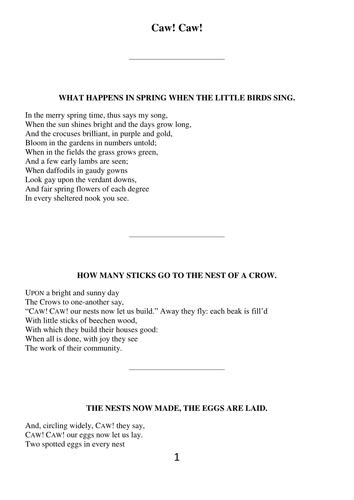












The chronicles of crows: A Tale of the Springtime (1848) - I have included the full poem, complete with the original pictures. I then provide it with the pictures and no words, and then the words and no pictures and finally as a simple CLOZE, where the students need to complete the missing word in the second line of each part of the poem.
The pictures without words are a charming Victorian border. The students could write their own Spring poems in this section and make a lovely Spring display.
I have always been drawn to crows, not in any dark teenage-poet way, but because they are big, handsome, super-clever, and remind me of the chilly Michigan spring.
It seemed so charming at first, with the crows working together, building their homes, laying their eggs and raising their babies in great swooping flocks.
But the story takes a ghastly turn as the nearby farmers gather to get rid of the rookery. I kept thinking that the smart, sassy crows would eventually outwit the mean, brutish humans.
How wrong I was. The crows are shot and made into pies, even the young ones, and the birds that survive are left to mourn, “How well we know / There is no joy unmixed with woe.”
Um, anyway, happy spring, and here’s a Monday assortment of pertinent items to help you get over the sense of mortal dread sinking in your chest after that morbid Victorian warning.
The pictures without words are a charming Victorian border. The students could write their own Spring poems in this section and make a lovely Spring display.
I have always been drawn to crows, not in any dark teenage-poet way, but because they are big, handsome, super-clever, and remind me of the chilly Michigan spring.
It seemed so charming at first, with the crows working together, building their homes, laying their eggs and raising their babies in great swooping flocks.
But the story takes a ghastly turn as the nearby farmers gather to get rid of the rookery. I kept thinking that the smart, sassy crows would eventually outwit the mean, brutish humans.
How wrong I was. The crows are shot and made into pies, even the young ones, and the birds that survive are left to mourn, “How well we know / There is no joy unmixed with woe.”
Um, anyway, happy spring, and here’s a Monday assortment of pertinent items to help you get over the sense of mortal dread sinking in your chest after that morbid Victorian warning.
Something went wrong, please try again later.
This resource hasn't been reviewed yet
To ensure quality for our reviews, only customers who have purchased this resource can review it
Report this resourceto let us know if it violates our terms and conditions.
Our customer service team will review your report and will be in touch.
£3.00